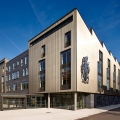Professor Gaynor Kavanagh is the former Dean of Cardiff Metropolitan’s School of Art and Design. She is the author of three books, including Dream Spaces: Memory and the Museum and has edited a further seven. She continues to write, play and muck about with ideas.
Can you tell us what you do?
Until October 2015, I was Dean of Cardiff School of Art and Design and am now an Emeritus Professor at Cardiff Metropolitan University.
I chair two charities. One of them, Open-Up Music, has just achieved National Portfolio Status and we will be launching the National Open Youth Orchestra next year. The other, Mothers of Africa, supports medical education and development in Africa.
I advise museums and provide courses that support those engaged with museum practice.
I also teach a week-long course on releasing creativity, which is the best fun ever!
I am on several academic panels, reviewing journals and research bids.
Why have you chosen to work in Cardiff?
I came to Cardiff to take-up the position of Dean at Cardiff Metropolitan in 2005 (then UWIC). For me, it was more than a job, it was about coming home and bringing my experience back to Wales. I am originally from Pontypool and it was so good to come back to where I belong. Until you return home, you don’t realise how much you’ve lived your life in a state of cultural translation. When I came to work at Cardiff Met, everything made sense again; I felt a strong sense of cultural identity that is life affirming.
What inspires you about being here?
It’s a European capital city. With a seat of government here, with so many things of national importance in Cardiff, it is such a powerful and impressive place.
It has all the attributes of the great capital cities that go beyond political power, multiculturalism, economic diversity and bilingualism, plus strong relationships with the country as a whole. Essentially, the sum of its parts is so much greater than the whole.
In the midst of this, Cardiff has a creative energy that is second to none, both formal and informal. I find Cardiff to be buoyant, resilient and dynamic.
What challenges have you found in working in Cardiff?
Aside from cycling across the city without killing myself?
Developing the School of Art and Design so that it is now of international importance was a very satisfying challenge. It involved bringing the School together in one location on one campus, with a curriculum driven by cutting edge research and enterprise. 
Delivering the new building on the Llandaff Campus was the best project! Designing something that could be of longstanding, with infinite flexibility, and something that would bring people together was a hugely fulfilling project, driven by a great team. I wanted the new building to generate a feeling of belonging and inclusiveness and I am so thrilled with that that has been achieved.
More negatively, I found that operating in a political environment that has a very narrow definition of the Creative Industries was a genuine challenge. ‘Creative Industries’ as a term, as used in the Assembly, refers specifically to media and substantially excludes design, making and art. As a result, these industries stand on the periphery when it comes to strategic priorities. The lack of vision in these areas is, at best, depressing.
Having been the Dean of Media and Culture, at Falmouth University, I understand the dynamics and economic potential of film, TV, broadcasting and web-based operations. I wouldn’t want to take anything away from them and how much they are bringing to Wales. The economic potential in them is fabulous. But, I think the narrow definition of ‘Creative Industries’ has given us a myopic perspective on the importance of creativity to the Welsh economy. This is a missed opportunity. The potential, particularly of emergent designers, makers, artists, as well as creative artisans, to the economy of Wales goes without the recognition that it deserves.
How successful do you think Cardiff has been at making itself a creative capital, particularly in your area of work?
In terms of art, design and making, Cardiff thrives because of the determined people operating in this sector, often against all odds.
Arguably, Cardiff is behind in its strategic thinking and planning for the arts and is being significantly outpaced by cities such as Newcastle, Glasgow and Bristol.
Its media and web-based industries are thriving and dynamic, of course, and are fabulous. I would like to think that part of this success is build on having a such a pool of talent that is home grown.
In terms of museums, the National Museum and the Cardiff Story are doing amazing things with remarkably diminished resources. I wish more people took pride in them; they are extraordinary in what they do and could and should be doing so much more.
In your opinion, which three things need to happen to make Cardiff a more creative city?
A first rate permanent gallery/museum dedicated to the contemporary arts, making and design. In my head, it’s a mixture of the Tate Modern and the contemporary ends of both the V&A and the Science Museum. Housed in a statement building, it could be a massive vote of confidence in Wales and its position in the world. I find it astonishing that Cardiff hasn’t got a major contemporary gallery or museum. There is something extraordinary we should be doing here.
I would like to see the Cardiff Story in a purpose built, centrally located museum, rather than hidden in a basement. A delegation needs to have a look at the Museum of Liverpool, People’s Palace in Glasgow and the Museum of London to help them recognise the potential here.
In a dream world, I would love to see the Royal Welsh College of Music and Drama and Cardiff School of Art and Design on the same campus, doing amazing things, perhaps with aspects of an integrated curriculum. It would never happen, of course, but if it ever did it would create an energy that would be earth moving and totally dazzling.
What do you think Creative Cardiff should try to achieve?
A new vision for the role of creativity in the social and economic fabric of the city; leading to the development of the sector as a vibrant expression of Cardiff as a multi-cultural, tolerant, inclusive city.
If it hadn’t been for Brexit, I would have said achieving the status of European Capital City of Culture.
Describe your favourite creative place to work in Cardiff
Well, it goes without saying, Cardiff School of Art and Design. Where else! Honestly, it was such a wonderful place to work. After a long day, I could walk through a studio and there would always be a gang of students working on something really interesting and new.
CSAD students build innovation upon innovation because they have complete commitment to what they do. My job as Dean was to make ensure that happened.
What’s next for you? What projects are on the horizon? What new ideas are you working on?
More of the same, with room for more.
I move forward in the words of Dag Hammarskjold, ‘for all that has been, thanks. To all that shall be, yes’.

